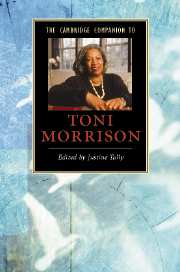Book contents
- Frontmatter
- Introduction: “All necks are on the line”
- Part I Toni Morrison’s fiction
- 1 The Bluest Eye and Sula: black female experience from childhood to womanhood
- 2 Song of Solomon and Tar Baby: the subversive role of language and the carnivalesque
- 3 Beloved or the shifting shapes of memory
- 4 Jazz and Paradise: pivotal moments in black history
- 5 The Morrison trilogy
- 6 Love and the survival of the black community
- 7 The artistic impulse of Toni Morrison’s shorter works
- Part II Toni Morrison’s criticism and editing
- Part III Essays
- Part IV Further Reading
- Index
6 - Love and the survival of the black community
from Part I - Toni Morrison’s fiction
Published online by Cambridge University Press: 28 January 2008
- Frontmatter
- Introduction: “All necks are on the line”
- Part I Toni Morrison’s fiction
- 1 The Bluest Eye and Sula: black female experience from childhood to womanhood
- 2 Song of Solomon and Tar Baby: the subversive role of language and the carnivalesque
- 3 Beloved or the shifting shapes of memory
- 4 Jazz and Paradise: pivotal moments in black history
- 5 The Morrison trilogy
- 6 Love and the survival of the black community
- 7 The artistic impulse of Toni Morrison’s shorter works
- Part II Toni Morrison’s criticism and editing
- Part III Essays
- Part IV Further Reading
- Index
Summary
Toni Morrison's eighth novel, Love (2003), foregrounds one of her most crucial concerns, a major theme recurrent in all her novels: how can love be defined, dissected, or accounted for? What are its multiple meanings and manifestations? In this her latest novel Morrison explicitly investigates the elusive nature of love in relation to heterosexual sex and pedophilia, but also to female friendship, mother-daughter and, especially, father-daughter relationships, and communal ties. As Morrison herself said in an interview with novelist Diane McKinney-Whetstone, “I was interested in the way in which sexual love and other kinds of love lend themselves to betrayal. How do ordinary people end up ruining the thing they most want to protect? And obviously the heart of that is really the effort to love.” In trying to answer these questions, Morrison tackles many key issues in her fiction: the empty category of “race” or the uselessness of racial boundaries, the rewriting of history from an African American standpoint, the importance of the survival of the community, the definition of black womanhood, and the crucial role of female bonding. This novel, therefore, becomes almost a compedium in which it is possible to see Morrison at her best, proving both her artistry as a gifted writer and her profound social commitment to the transmission of the values of the black community.
The novel recounts the story of Bill Cosey and the women who surround him, whose diverse stories center on their obsession with the patriarch of the family, defined as father, husband, lover, and, at times, friend. Twenty-five years after his death, his pervasive presence still shapes and conditions these women's responses to each other.
- Type
- Chapter
- Information
- The Cambridge Companion to Toni Morrison , pp. 92 - 100Publisher: Cambridge University PressPrint publication year: 2007

